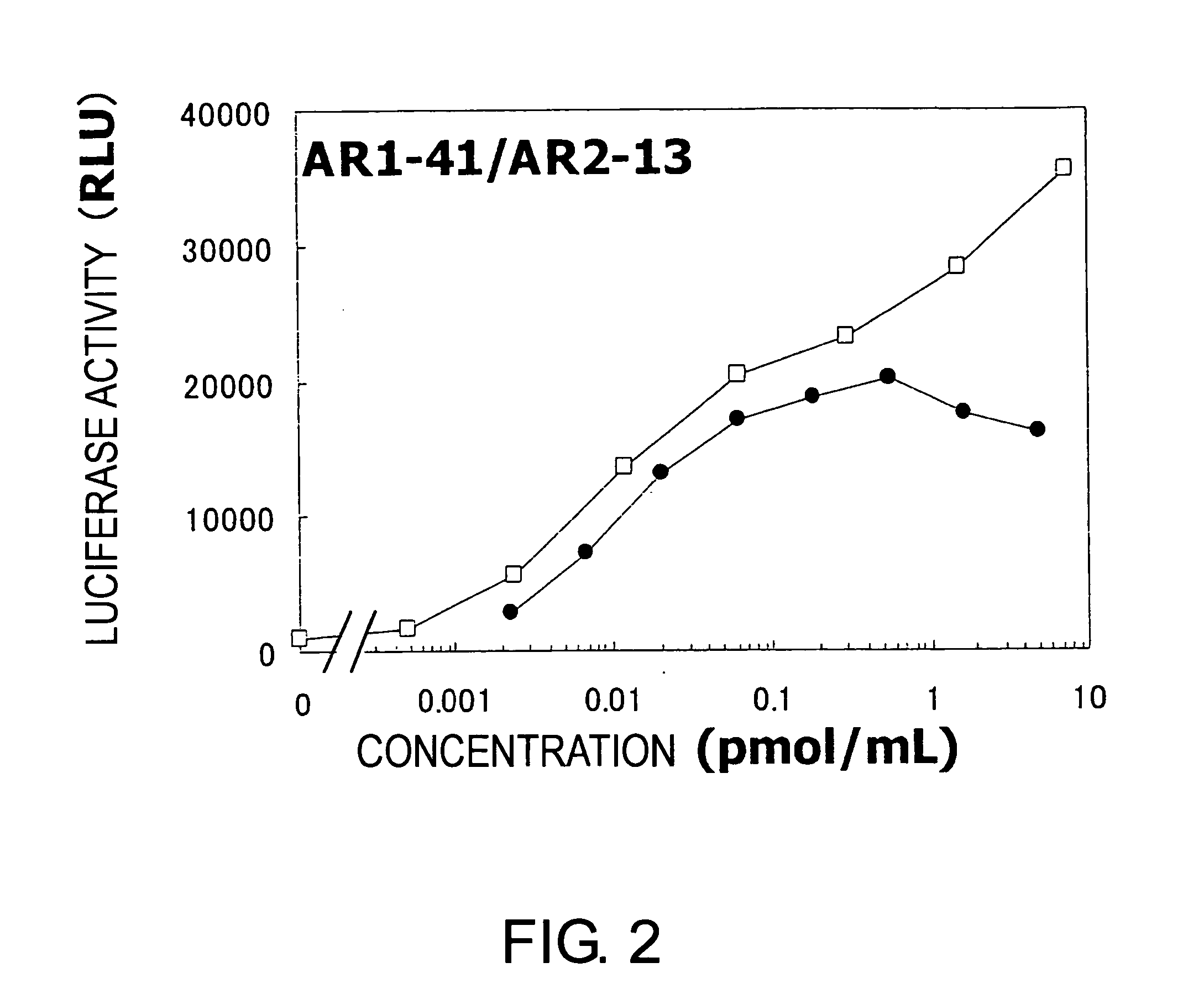Agonist antibody against heteroreceptor
a heteroreceptor and antibody technology, applied in the field of antibodies to heteroreceptors, can solve the problem that ordinary antibodies cannot be predicted to have agonist activity, and achieve the effect of reducing activity (function)
- Summary
- Abstract
- Description
- Claims
- Application Information
AI Technical Summary
Benefits of technology
Problems solved by technology
Method used
Image
Examples
example 1
Antigens and Immunization
[0086] CHO cells were transfected with an expression vector for a solubilized receptor comprising the extracellular domains of human AR1 and AR2 attached with FLAG or His6 tag at their C termini. The receptor was purified from the culture supernatant using an affinity column. An expression vector for the chimeric molecule that was formed between G-CSF receptor and the extracellular domain of human AR1 was introduced into mouse pro-B cell line BaF3 to establish a receptor-overexpressing cell line. Likewise, another cell line overexpressing the chimeric molecule between G-CSF receptor and the extracellular domain of human AR2 was established. Cells of each cell line were injected to the peritoneal cavity of BALB / c mice for immunization. Three days before spleen excision, AR1 His or AR2His was intravenously injected to the mice.
example 2
Isolation of Antibodies from a scFv-Presenting Library
(a) Panning of a Phage Library
[0087] PolyA(+) RNA was extracted from the spleens of immunized mice, and scFv was then synthesized by RT-PCR. A plasmid library was constructed that expresses scFv as a fusion protein with the product of the f1 phage gene 3 (J. Immun. Methods, 201, (1997), 35-55). An E. coli library (2×109 cfu) was inoculated to 50 ml of 2×YTAG (2×TY containing 100 μg / ml ampicillin and 2% glucose), and the culture was incubated at 37° C. until OD600 reached 0.4-0.5. 4×1011 helper phage VCSM13 were added, and the culture was allowed to stand for 15 minutes at 37° C. to be infected. 450 mL of 2×YTAG and 25 μl of 1 mol / l IPTG were added to the culture, and incubated at 26° C. for ten hours. The culture supernatant was collected by centrifugation. 100 ml of PEG-NaCl (10% polyethylene glycol 8000 and 2.5 mol / l NaCl) was combined with the supernatant, and allowed to stand at 4° C. for 60 minutes. Phages were precipitat...
example 3
Expression of Bispecific Antibodies
[0090] The expression vector pCAGGss-g4CH-hetero-IgG4 was constructed to express scFv-CH1-Fc. scFv can be inserted into the vector at the SfiI site, between intron-CH1-Fc (human IgG4 cDNA) and the human signal sequence driven by the CAGG promoter. With reference to IgG1 knobs-into-holes technology (Protein Engineering vol. 9, 617-621, 1996, Nature Biotechnology vol. 16, 677-681, 1998), the amino acids of the CH3 of IgG4 were substituted in order to express heteromeric molecules. Type A are Y349C and T366W mutants; and type B are E356C, T366S, L368A, and Y407V mutants. In addition, an amino acid was substituted in the hinge domain for both mutant types (from -ppcpScp- to -ppcpPcp-). Types A were constructed using the human IL-3 signal sequence, while types B were constructed using the human IL-6 signal sequence (pCAGG-IL3ss-g4CHPa and pCAGG-IL6ss-g4CHPb). PCR products, corresponding to the scFv regions of the clones selected based on their nucleoti...
PUM
| Property | Measurement | Unit |
|---|---|---|
| Composition | aaaaa | aaaaa |
Abstract
Description
Claims
Application Information
 Login to View More
Login to View More - R&D
- Intellectual Property
- Life Sciences
- Materials
- Tech Scout
- Unparalleled Data Quality
- Higher Quality Content
- 60% Fewer Hallucinations
Browse by: Latest US Patents, China's latest patents, Technical Efficacy Thesaurus, Application Domain, Technology Topic, Popular Technical Reports.
© 2025 PatSnap. All rights reserved.Legal|Privacy policy|Modern Slavery Act Transparency Statement|Sitemap|About US| Contact US: help@patsnap.com



